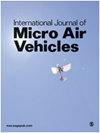用声音看;通过感应自生噪声进行表面探测和规避
IF 1.6
4区 工程技术
Q2 ENGINEERING, AEROSPACE
引用次数: 0
摘要
在这里,我们展示了四旋翼无人机的避障和二次无人机能力,当它们靠近表面时,可以感知并对其自身产生的声学环境的调制做出反应。通过测量无人机在消声室内的固有三维声学特征,建立了解释自噪声的基本事实。这被用于设计传感器布置和机器学习算法,以估计外部特征、障碍物或其他无人机在环境中的位置。我们的机器学习方法采用记录声音的短片段及其傅立叶变换,将其输入卷积神经网络,并输出环境中障碍物或次要无人机的位置。卷积层是用合适的拓扑结构构建的,该拓扑结构与传感器的物理布置相匹配。我们的表面检测和规避算法在消声室内的系留飞行过程中进行了改进,然后进行了无障碍自由飞行练习,最后进行了自由飞行障碍检测和规避。我们的声学感知和躲避能力扩展到垂直和水平平面以及系留的辅助无人机。本文章由计算机程序翻译,如有差异,请以英文原文为准。
Seeing with sound; surface detection and avoidance by sensing self-generated noise
Here, we demonstrate obstacle and secondary drone avoidance capability by quadcopter drones that can perceive and react to modulation of their self-generated acoustic environment when in proximity to surfaces. A ground truth for the interpretation of self-noise was established by measuring the intrinsic, three-dimensional, acoustic signature of a drone in an anechoic chamber. This was used to design sensor arrangements and machine learning algorithms to estimate the position of external features, obstacles or another drone, within the environment. Our machine learning approach took short segments of recorded sound and their Fourier transforms, fed these into a convolutional neural network, and output the location of an obstacle or secondary drone in the environment. The convolutional layers were constructed with a suitable topology that matched the physical arrangement of the sensors. Our surface detection and avoidance algorithms were refined during tethered flight within an anechoic chamber, followed by an exercise in free flight without obstacle avoidance, and finally free flight obstacle detection and avoidance. Our acoustic sense-and-avoid capability extends to vertical and horizontal planar surfaces and tethered secondary drones.
求助全文
通过发布文献求助,成功后即可免费获取论文全文。
去求助
来源期刊

International Journal of Micro Air Vehicles
ENGINEERING, AEROSPACE-
CiteScore
3.00
自引率
7.10%
发文量
13
审稿时长
>12 weeks
期刊介绍:
The role of the International Journal of Micro Air Vehicles is to provide the scientific and engineering community with a peer-reviewed open access journal dedicated to publishing high-quality technical articles summarizing both fundamental and applied research in the area of micro air vehicles.
 求助内容:
求助内容: 应助结果提醒方式:
应助结果提醒方式:


